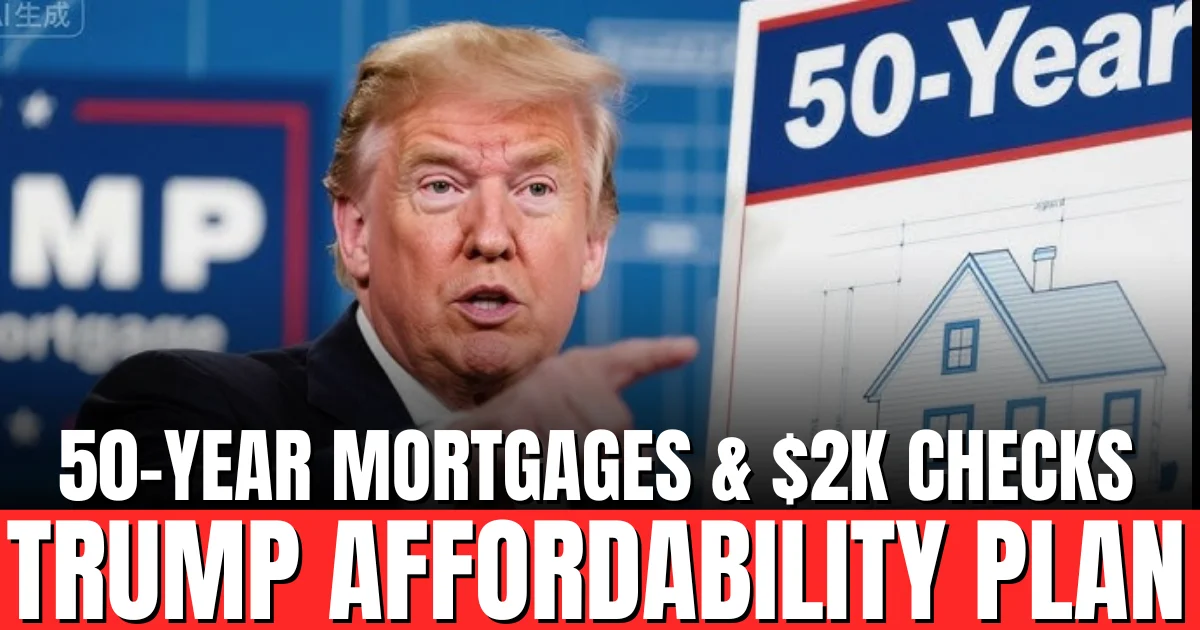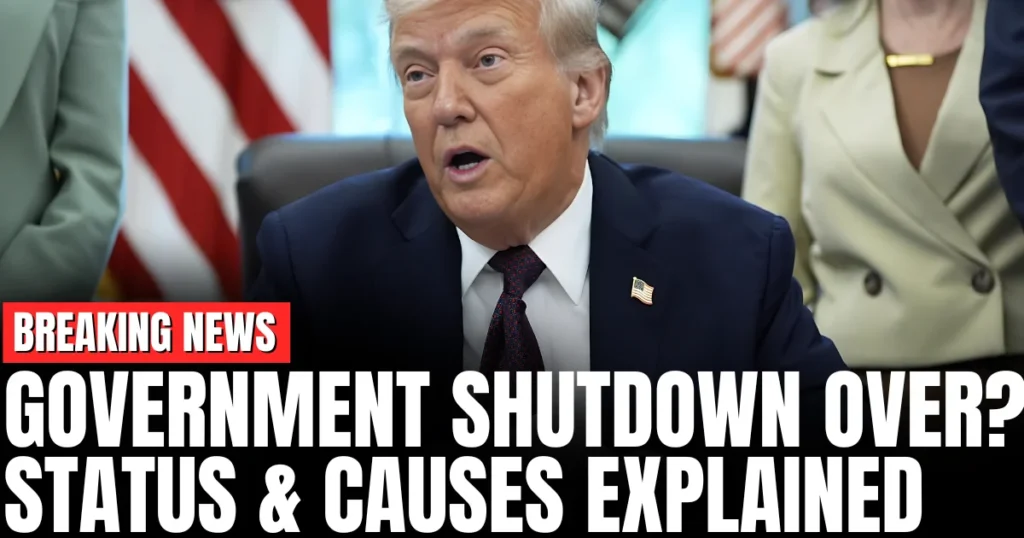Trump proposes 50-year mortgages and $2,000 direct payments to address housing crisis. How it works, pros/cons, expert analysis. Complete breakdown!
Table of Contents
Trump Administration Unveils Housing Affordability Package with Extended Mortgages and Direct Payments
Controversial Proposals Include Five-Decade Home Loans and $2,000 Checks as President Addresses Cost-of-Living Crisis
The Trump administration has announced a sweeping housing affordability initiative that includes federal backing for 50-year mortgages and direct $2,000 payments to middle-class families struggling with living costs. The proposals represent the administration’s most aggressive response yet to persistent inflation and housing unaffordability that have dominated economic concerns since Trump’s return to office.
The plan, unveiled during a White House economic policy address Thursday, aims to reduce monthly housing costs through extended loan terms while providing immediate relief through direct payments similar to pandemic-era stimulus checks. Treasury Secretary Scott Bessent characterized the measures as “bold, necessary action to restore the American Dream of homeownership and economic security.”
“Americans are being crushed by inflation and unaffordable housing,” Trump stated during the announcement. “We’re taking decisive action with 50-year mortgages that cut monthly payments dramatically and putting $2,000 directly in families’ pockets. This is real relief for real Americans.”
The proposals have generated immediate controversy, with supporters praising creative solutions to genuine affordability crises while critics warn of unintended consequences ranging from increased total borrowing costs to inflationary pressure that could worsen the problems the policies aim to solve. Economic analysts are divided on whether the measures address root causes or merely mask symptoms of deeper structural issues.
What the Proposals Actually Include
50-Year Mortgages Explained
Federal Backing for Extended Loans:
The administration proposes FHA and VA loan programs offer 50-year mortgage options:
How It Works:
- Borrowers spread payments over 600 months instead of standard 360
- Lower monthly payments (approximately 15-20% reduction)
- Federally-backed insurance makes loans attractive to lenders
- Voluntary option, not replacement of 30-year mortgages
Example Calculation:
| Loan Amount | 30-Year Payment | 50-Year Payment | Monthly Savings |
|---|---|---|---|
| $300,000 (5% rate) | $1,610 | $1,347 | $263 (16%) |
| $400,000 (5% rate) | $2,147 | $1,796 | $351 (16%) |
| $500,000 (5% rate) | $2,684 | $2,245 | $439 (16%) |
The Trade-Off:
While monthly payments decrease significantly, total interest paid increases dramatically:
- 30-year loan (300k):Totalpaid=∗∗300k):Totalpaid=∗∗579,600**
- 50-year loan (300k):Totalpaid=∗∗300k):Totalpaid=∗∗808,200**
- Additional cost: $228,600 over life of loan
$2,000 Direct Payments
Middle-Class Rebate Program:
Eligibility:
- Individual income: 75,000−75,000−125,000
- Married couples: 150,000−150,000−250,000
- Phased reduction above thresholds
- U.S. citizens and permanent residents
Distribution:
- One-time payment via direct deposit or check
- Estimated 92 million households eligible
- Total program cost: $184 billion
- Distribution timeline: 4-8 weeks after approval
Funding Mechanism:
Administration proposes funding through:
- Budget reallocation from discretionary programs
- Reduced foreign aid spending
- Anticipated economic growth revenues
- Deficit spending (controversial)
Why These Policies Now?
The Affordability Crisis
Housing Market Reality:
Median Home Prices:
- National median: $412,000 (up 38% since 2020)
- Coastal markets: 600,000−600,000−1,000,000+
- First-time buyer affordability at 40-year low
Mortgage Rates:
- Current average: 6.8-7.2% (30-year fixed)
- Up from pandemic-era lows of 2.5-3%
- Monthly payment impact severe compared to 2020-2021
Rent Burden:
- Average 1-bedroom apartment: 1,400−1,400−1,800 nationally
- 30-50% of income for many renters
- Homeownership increasingly out of reach
Political Pressure:
Trump campaigned on addressing cost-of-living issues, making affordability policies central to his economic agenda and 2026 midterm positioning.
Electoral Calculations
Target Demographics:
Suburban Families:
- Swing voters in competitive districts
- Struggling with housing costs
- Direct payment appeals to immediate needs
Young Professionals:
- Locked out of homeownership
- 50-year mortgages could enable buying
- Key demographic for Republican growth
Working/Middle Class:
- Inflation squeezing budgets
- Symbolic value of direct relief
- Traditional Trump base
Arguments For the Proposals
Supporters’ Rationale
Housing Secretary Doug Burgum:
“Fifty-year mortgages give young families access to homeownership that 30-year loans now prevent. Lower monthly payments mean the difference between renting forever and building wealth through equity.”
Key Benefits Cited:
Immediate Affordability:
- 15-20% lower monthly housing costs
- Makes homeownership accessible to more families
- Frees up monthly budget for other expenses
Market Stimulation:
- Increased home buying activity
- Construction industry boost
- Economic growth through housing sector
Wealth Building:
- Homeownership entry point for those currently excluded
- Equity accumulation even with higher total costs
- Intergenerational wealth creation
Direct Relief:
- $2,000 provides immediate financial cushion
- Helps with debt, emergencies, necessities
- Stimulates consumer spending
Arguments Against the Proposals
Critics’ Concerns
Economic Analysts’ Warnings:
Increased Total Costs:
50-year mortgages mean borrowers pay 200,000−200,000−400,000 more in interest over loan life.
Equity Building Delays:
- First 20 years barely reduce principal
- Longer time to build wealth
- Homeowners remain underwater longer
Inflationary Pressure:
- Direct payments inject $184 billion into economy
- Could worsen inflation the policy aims to address
- Federal Reserve rate hikes counterproductive
Housing Bubble Risk:
- Easier financing inflates demand
- Prices rise further defeating affordability purpose
- 2008 crisis parallels concerning
Fiscal Responsibility:
- $184 billion added to deficit
- No sustainable funding source
- Future taxpayers bear costs
Expert Perspectives
Dr. Mark Zandi, Moody’s Analytics:
“While well-intentioned, 50-year mortgages don’t address the fundamental problem: insufficient housing supply. This could actually raise prices by increasing buyer capacity without adding homes.”
Professor Susan Wachter, Wharton School:
“The $2,000 payments provide temporary relief but risk fueling the very inflation making life unaffordable. We need supply-side solutions, not demand-side stimulus.”
American Enterprise Institute Analysis:
“These policies address symptoms, not causes. Real affordability requires building more housing, reforming zoning, and reducing construction costs—none of which these proposals accomplish.”
International Comparisons
How Other Countries Handle Housing
Japan:
- 50-year and even 100-year multi-generational mortgages common
- Different property value dynamics (depreciation vs. appreciation)
- Cultural acceptance of long-term debt
United Kingdom:
- Recently introduced 40-year mortgages
- Similar affordability crisis
- Mixed results on actual accessibility
Denmark:
- Flexible mortgage systems with various term lengths
- Strong social housing sector
- Different ownership models
Lesson:
Long-term mortgages alone don’t solve affordability without addressing supply constraints and market fundamentals.
Political Implications
2026 Midterm Positioning
Republican Strategy:
- Tangible economic relief to point to
- Populist appeal to working/middle class
- Contrast with Democratic alternatives
Democratic Response:
- Criticize as fiscally irresponsible
- Propose alternative housing policies
- Emphasize inflation risks
Swing Voter Impact:
Polling shows affordability policies popular in principle, but details matter for actual support.
What Happens Next
Implementation Timeline
Legislative Requirements:
- Congressional approval needed for funding
- FHA/VA program changes require legislation
- House Republican support likely
- Senate passage uncertain
Regulatory Process:
- HUD rulemaking for mortgage programs
- IRS implementation for payments
- Banking industry adjustments
- 3-6 month timeline minimum
Frequently Asked Questions (FAQs)
How do 50-year mortgages reduce monthly payments?
Fifty-year mortgages reduce monthly payments by spreading loan repayment over 600 months instead of the standard 360 months (30 years). This longer timeframe decreases each payment by approximately 15-20%. For example, a $300,000 loan at 5% interest costs $1,610 monthly over 30 years but only $1,347 over 50 years—a $263 monthly savings. However, total interest paid increases dramatically from $579,600 to $808,200, costing an additional $228,600 over the loan’s life.
Who qualifies for the $2,000 direct payments?
The proposed payments target middle-class families with individual incomes between 75,000−75,000−125,000 or married couples earning 150,000−150,000−250,000. Payment amounts phase out above these thresholds. Eligibility requires U.S. citizenship or permanent residency. The administration estimates 92 million households qualify. Distribution would occur via direct deposit or check within 4-8 weeks of congressional approval. The one-time payment totals $184 billion in program costs.
Don’t longer mortgages just mean paying more interest?
Yes, significantly more. While 50-year mortgages reduce monthly payments, borrowers pay substantially more total interest over the loan’s life. A $300,000 loan costs an additional $228,600 in interest compared to a 30-year term. Equity builds much slower in the early decades. Critics argue this trades short-term affordability for long-term wealth destruction. Supporters counter that homeownership entry matters more than total costs, and borrowers can refinance or pay extra principal when able.
Could these policies make inflation worse?
Many economists warn yes. Injecting $184 billion in direct payments increases consumer spending and demand, potentially driving prices higher—the opposite of the intended affordability effect. Additionally, 50-year mortgages increase housing demand without adding supply, likely raising home prices further. The Federal Reserve might respond with higher interest rates, counteracting the affordability benefits. Critics argue supply-side solutions (building more housing) would better address root causes without inflationary risks.
When would these programs actually start if approved?
Implementation requires Congressional legislation, regulatory rulemaking, and administrative setup—a process taking minimum 3-6 months even with fast-tracking. Direct payments could distribute within 4-8 weeks after bill signing if prioritized. Fifty-year mortgage programs need HUD rulemaking, banking industry preparation, and lending infrastructure adjustments, likely taking 6-12 months. Political obstacles could delay or prevent passage entirely. If approved in coming months, expect programs operational late 2025 or early 2026.
Conclusion: Bold Proposals with Uncertain Outcomes
Trump’s housing affordability package combining 50-year mortgages and $2,000 direct payments represents ambitious policy intervention addressing genuine economic pain millions of Americans experience. The proposals recognize that housing unaffordability and cost-of-living pressures create real hardship requiring governmental response beyond rhetoric.
Whether these specific policies constitute effective solutions remains intensely debated. Supporters view them as creative approaches making homeownership accessible and providing immediate relief when families desperately need help. The political appeal is obvious—lower monthly payments and direct checks deliver tangible, understandable benefits.
Critics warn of unintended consequences potentially worsening the very problems targeted. Longer mortgages dramatically increase total borrowing costs while slowing equity building. Direct payments risk fueling inflation. Neither addresses fundamental supply constraints driving housing unaffordability. The policies might provide temporary relief while creating long-term problems.
The deeper question is whether demand-side stimulus through easier financing and direct payments can solve affordability crises rooted in insufficient supply, zoning restrictions, construction costs, and market fundamentals. Economic consensus suggests supply-side solutions—building more housing, reforming regulations, reducing barriers—better address root causes than making expensive homes easier to finance.
For Trump politically, the proposals deliver concrete policies addressing campaign promises and positioning for 2026 midterms. Whether they pass Congress, survive implementation, and actually improve affordability will determine their ultimate success or failure.
For Americans struggling with housing costs, the debate over these proposals matters less than finding real solutions to genuine crisis. Whether 50-year mortgages and $2,000 checks represent effective answers or expensive distractions remains to be seen.

